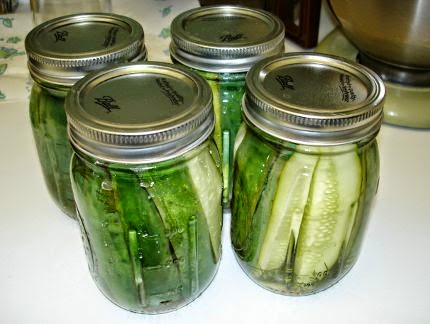If you've got a fridge and some cucumbers, zucchini, or watermelon, you can make pickles!
I love crunchy dill pickles, but conventional pickles have many harmful ingredients in them.
Pickles make great snacks, satisfying food cravings without throwing off your daily intake of calories, fats, sugars or carbohydrates. Like most fermented foods, natural pickles provide PROBIOTIC benefits. Unfortunately, most commercially sold pickle brands contain high fructose corn syrup and/or food dye. Food manufacturers dye pickles as a marketing ploy to enhance the shelf-appeal of their product, hoping consumers will choose the brightest pickles from the supermarket shelves. A few manufacturers using turmeric to create the yellowy tinge which makes green pickles appear brighter. However, as an April 2011 article in the New York Times noted, natural food dyes are "not as bright, cheap or stable as artificial colorings, which can remain vibrant for years."
Approximately 60%-70% of all dyes used in food and textile manufacturing are what are called azo dyes, processed from industrial waste. The ingredient responsible for the yellow color in many commercial pickles is the azo dye tartrazine, made from coal-tar derivatives. Many azo dyes are known to be mutagenic, meaning they cause mutations (changes in cell DNA). The National Cancer Institute has stated that mutagenic substances are carcinogens.
For example: Here are the ingredients in one conventional popular dill pickle brand -
Vlasic Hamburger Dill Chips Pickles: cucumbers, water, distilled vinegar, salt, calcium chloride, sodium benzoate (preservative), natural, polysorbate 80, yellow 5.
Making your own homemade refrigerator pickles is a great way to enjoy pickles without the added harmful ingredients.
They're ridiculously easy to make and will last a few months in your fridge, without the hassle of dragging out all your canning equipment. You're basically just adding vegetables—or watermelon rinds, green beans, carrots or anything else your pickling heart desires—to a mixture of vinegar and salt; just about any vegetable can be turned into a refrigerator pickle, so don't limit yourself to pickling cucumbers only. Homemade pickles are healthy, too, if you use an organic, unpasteurized cider vinegar, such as Bragg's, that's full of immune-boosting PROBIOTICS.
The following two basic recipes are delicious in their own right, but they are also a starting place for limitless variations using different veggies and seasonings. Add more garlic, add spicy red pepper for hot pickles, or substitute other HERBS for the dill. Just take advantage of whatever ingredients you have in your garden or find at your local farmer's market.
Classic Dill Pickles (1 quart)
Ingredients:
5 medium cucumbers
1 Tablespoon pickling salt, sea salt, or kosher salt (but not iodized table salt)
1 cup cider vinegar
1 cup water
1 head dill or small bunch dill leaves
1 clove garlic (optional)
3 black peppercorns (optional)
Directions:
For the crunchiest pickles, select firm, dark-green pickling cucumbers that have not started to ripen to white or yellow. Cut them into spears or slices, as desired (left whole, they will take a long time to pickle in the fridge). To increase the crunchiness, you can sprinkle the cut cucumbers with a couple of tablespoons of salt, let them sit for 2 hours, and then rinse and drain before proceeding, but this step isn't absolutely necessary. I rarely bother with it.
Prepare a quart jar with a lid by running it through the dishwasher or washing it in very hot soapy water and letting it air-dry. Any jar with a lid will do; the wider the opening, the easier.
Place the dill in the bottom of your jar, peel and crush the garlic clove (if using), and drop that in along with the peppercorns (if using), then put in the cut cucumber. Mix the salt, vinegar, and water in a separate container, stirring until the salt is dissolved, then pour it over the cucumbers, filling the jar right to the top. If you're in a hurry to enjoy your pickles, heat the vinegar, water, and salt to a boil before pouring it over the cucumbers (just know that heating unpasteurized vinegar kills off the healthy PROBIOTIC bacteria that make pickles good for you). Pop on the lid and put the jar in the fridge.
Bread and Butter Pickles (1 quart)
Dill pickles are good, but if you like your pickles sweet and tangy, these bread-and-butter pickles fit the bill.
Ingredients:
3 cups sliced cucumbers
1 cup sliced onions (or half onions and half green pepper)
1 clove garlic, peeled and sliced (optional)
1 Tablespoon pickling salt, sea salt, or kosher salt (but not iodized table salt)
1 cup apple cider vinegar
7/8 cup raw honey, or stevia to taste
1 Tablespoon whole mustard seeds
1 teaspoon ground turmeric
½ teaspoon celery seed
2 cloves, whole
Directions:
Prepare jar and veggies as you would for Dill Pickles. Combine the remaining ingredients in a stainless steel saucepan, bring them to a boil, and simmer until the sugar or honey is dissolved. Put the veggies into the jar and pour the vinegar mixture over them, stirring to make sure all veggies come in contact with it. Cover and refrigerate.
Recycle Your Pickle Juice!
Last, but not least: After you chase down the last pickle in the jar, STOP—don't dump that juice! It's all ready and waiting for another batch of pickles. Just slice or chop up fresh veggies and drop them into the jar. The pickle juice should completely cover the veggies. If it doesn't, take out some of the veggies or add a bit of vinegar, and shake. Screw on the lid and put it back in the fridge. Let the juice soak for a few days and then, enjoy! CONTINUE to reload the jar as long as the pickles' flavor continues to please you.
Enjoy!
Intuitively Yours,
Laurel xxxx


No comments:
Post a Comment
Please send your comments to Healthy Intuitions: